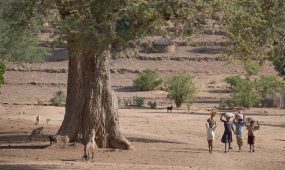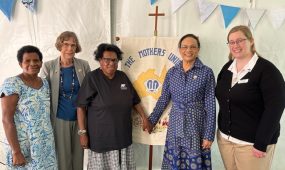Reconciliation Prayer Spaces
News
As part of our continuing series on Reconciliation Action Plan achievements, The Rev’d Susan Crothers-Robertson tells us about how St John’s Anglican College primary students recently explored Reconciliation Prayer Spaces with students opening themselves to awe and wonder: “When the students were welcomed into the prayer space, it felt there was an inner hospitality, an inner awakening, that God was inviting us into a deeper sense of being, as we reflected on the first peoples of the land”

Story Timeline
Reconciliation Action Plan achievements
- Pilgrimage to Wontulp-Bi-Buya (WBB) College
- St Mark’s supporting First Nations constitutional reform
- New Anglicare SQ cards further Reconciliation journey
- PATSIMAC group creating welcome and honouring the culture of the Yugambeh people
- Anglicare’s Reconciling Histories project
- SEQ Friends of Nungalinya College – building cultural bridges
- Reconciliation: relationships and respect
- Exploring mission in a post-colonial Australian church
- First Nations ‘icons’ – a portal to Aboriginal and Torres Strait Islander Spiritualities
- Ancient Aboriginal practice meets Divine Christian call
- Stunning Aboriginal dot paintings to travel around our Diocese
St John’s Anglican College recently held a Reconciliation Prayer Space at the Primary school. Prayer Spaces work on a deeply spiritual level, as students reflect and pray about themselves, the other, the world and the Divine Love.
The week-long Reconciliation Prayer Space reinforced the Diocesan RAP, in that the students and staff were able to come to a better understanding and appreciate Aboriginal and Torres Strait Islander culture and history. Students from Kindy to Year Six attended the Reconciliation Prayer Space, which weaved through the Christian story as it connected with the Aboriginal and Torres Strait Islander stories.
When the students were welcomed into the prayer space, it felt there was an inner hospitality, an inner awakening, that God was inviting us into a deeper sense of being, as we reflected on the first peoples of the land. In this particular Prayer Space, the students were invited to reflect, think and pray about Reconciliation.
They did this by engaging with eight different Prayer Stations which were designed by The Rev’d Gillian Moses, The Rev’d Susan Crothers-Robertson and Chaplain Juliana. The stations included:
Peace Fish – students were invited to write or draw what peace might look like to them, and then place the fish in the river.
Message Sticks – students were invited to think about Aboriginal and Torres Strait Islander culture, in particular, the use of the message stick. They were then asked to write a prayer or message on the stick and leave it in the sand.
Bark Canoe – canoes are an important part of Torres Strait Islander and Aboriginal cultures. In the Bible, boats were often a sign of life and security. Students were invited to write their hopes and dreams for the future.
Advertisement
Rainbow Serpent – students were asked to think about what was precious to them. They reflected on the relationship Torres Strait Islander and Aboriginal peoples had with ‘country’. They then decorated a hand to represent these connections and then added the hand to the rainbow serpent.
Neighbours of this red earth – the students were invited to colour in the Aboriginal and Torres Strait Islander flags, and while they did this, to think about who is their neighbour and pray and think about them. They then stuck the flags on the glass wall.

St John’s Anglican College Year Six students colouring in Aboriginal and Torres Strait Islander flags at the Neighbours on this Red Earth prayer station in May 2019
Journey of Reconciliation – during National Reconciliation Week, we remember the history between Aboriginal and Torres Strait Islander peoples and the colonisers. They reflected on their hopes and prayers for Australia and then added a dot to the dot painting.
Dreamtime stories – the Aboriginal and Torres Strait Islander Dreamtime stories are an oral textbook which is passed from one generation to the next. Christians and other religions also tell stories which are passed from generation to generation. Students were invited to draw an image to show their part in the story.
Advertisement
Dreaming – within Aboriginal and Torres Strait Islander cultures, dreaming is central to their beliefs. Students were invited to dream – sit quietly and reflect and slow down.
The following are some responses from the students who attended the Reconciliation Prayer Space.
“I felt like there was a connection with God.”
“I learnt about Reconciliation, and that friendship is an important way of working with reconciliation.”
“I learnt about identity, and the importance of seeing past colour, so we can connect with all people.”
“I learnt not to judge people for how they look, and it is important to understand how people feel.”
Many students also commented about how they felt calm, peaceful, and able to have time out of their busy school day. They also spoke about connecting their story to the dreamtime story.
The Reconciliation Prayer Space reminded me of God’s generous hospitality. School life can be a very busy and demanding time for students. Prayer Space offers God’s generous hospitality by inviting the students to slow down, and just for a few minutes, open themselves to awe and wonder. It is this openness, which allows quiet moments, that can create a deep spiritual connection in ways that words cannot describe.
A recent article I read talked about ‘visual prayer’. The Prayer Space changes and evolves each time a new class enters the Prayer Space and interacts with the activities.
When the students interact with the activities, they are adding their story – they are part of the story. The Prayer Space is a living, dynamic and sacred space where students are respectful and peaceful. For the most part, the students move easily into a time of quiet, excited and open to what they may discover. One of the most moving times was when I was sitting on the floor with some students as we coloured in the Torres Strait and Aboriginal flags.
The students had been encouraged by their teacher to be completely silent in the Prayer Space. To witness the students being silent was spiritually moving as it gave the students time to reflect about Reconciliation and the first peoples of the land on which we were now sitting. At that moment, there seemed to be a deep connection with each other and the earth.





